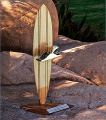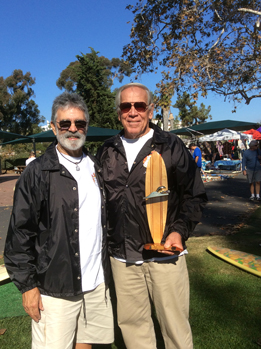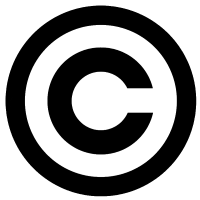Inductee Bio
Jim Foley Autobiography
1953...Involved with father,building surfboards out of wood planks and plywood, always experimenting with shapes, materials, and construction methods. He built few solid plank boards and several hollow plywood designs.
1954...I surfed hollow plywood boards and experimented with many fin shapes, (since they were attached with "L" brackets they were easy to exchange). I learned a lot about fins.
1955...With a load of war-surplus life raft balsa wood, I glued up "blanks" and began shaping balsa surfboards. Most shapes were copied from what I had seen in Southern California. (Malibu to San Onofre).
I had started my ocean wave riding experience on rubber surf matts. (1950) I enjoyed its maneuverability. For me being able to stay deep in the "curl" was the real enjoyment of riding a wave. I wanted a surfboard that could accomplish the same thrill.
I realized the importance of a very light weight surfboard for the performance I was looking for. Life raft balsa was still too heavy (I even tried hollowing out the balsa boards before glueing up blanks).
1956...I heard about Styrofoam insulation boards. They were 2 feet wide, 4 inches thick and 8 feet long. Two boards glued together with a light weight 1/4 inch plywood stringer made an ideal blank to experiment with. I covered the Styrofoam with a watered down solution of Weld-wood glue to act as a barrier between the polystyrene foam and the polyester fiberglass'resin. Apart from low density foam being difficult to work with at first, I was soon able to shape and glass several boards. It was so cheap to build these boards I could experiment with practically any shape I could think of. I sometimes showed up at the beach with three or four experimental boards to try out.
I felt that for my style and surfing enjoyment a board should be as light as possible and as short as possible yet still be long enough to catch a wave. Also strong enough to punch through a big wave.
I once tried a 6 foot board with only one layer of 4oz cloth as a deck patch. It weighed about 10 pounds. It was just what I had always dreamed of. I was only able to ride two waves with that board before it broke in half but I realized I would concentrate on making a stronger version of a board with these parameters.
This was about the same time Hobie, Jack O'Neill and Clark were working on blowing polyurethane foam into the rough shape of a surfboard. It became obvious that urethane foam with its compatibility with polyester resin was the way to go.
1959...I was studying Industrial Design in college when long time friend, Jack O'Neill offered me a job shaping boards for the Surf Shop. Part of the deal was I could shape a board for myself whenever I wanted but had to turn in the old board before I could make a new one. It was great for me since the boards I wanted to ride were much shorter than anything being built. However selling my old boards wasn't that easy for Jack but he was supportive and didn't complained about the short little boards laying around the shop that nobody wanted to buy. They were between 6 and 7 feet long and I think parents bought them for little kids! At the time long boards 9 to 10-6 were the standard. Most of the shaping I did for O'Neill was custom order stuff. They fill in the numbers on the order form and unless there was something way off I would adjust a template to fit their numbers, or recommend some modification. It was a time when tail blocks and nose blocks were cool, everyone wanted to nose ride, make long cut backs and imitate some maneuver they saw in a surf movie. Concaves and bump boards were also popular. I shaped these boards that I would seldom if ever ride for about four years. I stuck with my short board ideas but kept a couple of 8 or 9 foot boards for big days at Steamer Lane.
When windsurfing became popular I started shaping my own boards. I enjoyed windsurfing. I feel I learned more about rail edges, tail shapes and "V" bottoms and concaves from windsurfing than several years of wave surfing. While planing across flat water I could look down at my board and study the actual flow of water under and exiting the board. It was a great learning experience on wave board design.
Today... My love for the ocean and waves and things to ride across the ocean is still very much alive. In 1964 I designed a racing trimaran and a few years later a 36 foot light monohull. This was followed by a 32 foot ultra light racing monohull made out of a core of Clark foam! Much of my designing reflects back to what I learned from surf boards and windsurfers.
The last time I talked to Hobie Alter (at a Hobie Cat Regatta in 1975) he surprisingly asked me how it feels to see all these guys ridding my short boards. I don't take credit for the short board revolution but I was honored that this man I had known and admired for so many years remembered my short board surfing history.
I also received an e-mail a couple of months ago from Bob McTavish in Australia. He had got my address from a mutual friend and wanted to tell me that he had shaped about 40 "Foley Boards" (as they were called in Australia) back in the sixties and wanted to keep in touch.
|
| For the complete biography, go to: |




